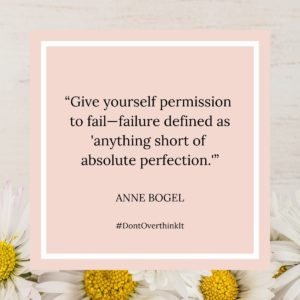Something has to give. You keep going back to square one, starting a new workout plan or giving up diet Coke on a regular basis. But it never lasts for long. You feel like you know what to do to get healthy but you can’t seem to make yourself do it for longer than a few weeks.
The answer to staying power isn’t joining another boot camp or trying a different diet plan. Creating the life you want means, on some level, letting go of the life you have. It’s about more than going to the gym and eating your veggies. It’s about going deep.
While you may need to change some of your tools, the foundation for lasting change starts with your belief system. You need to upgrade your personal operating system to reflect new ways of thinking and acting in your everyday life. I’ve got three books to help you upgrade your thinking and create the life you want.
Do you suffer from analysis-paralysis?
Your first upgrade starts with letting go of all or nothing thinking. This means working on perfectionist tendencies and finding ways to overcome analysis-paralysis. I recommend picking up Don’t Overthink It by Anne Bogel to start digging into the overthinking problem.
All or nothing thinking and overthinking are linked together by the perfectionism trap. “If I can’t do it perfectly, I won’t do it all.” That’s the message most women work with. Faced with anything less than guaranteed success, it’s easy to talk yourself out of signing up for a martial arts class or attempting to give up dairy.
It’s even easier to get stuck in analysis-paralysis. You keep looking for the right class or the best meal plan. You keep looking for guarantees and a perfect fit. Instead of just trying something to see how it feels, you do nothing. The best way to get past analysis-paralysis (and all or nothing thinking) is to do something. Bogel says, “you don’t need more information. You need to act.”
In her book, Bogel gives the same advice I do – think like a scientist. View your choices as experiments. An experiment doesn’t come with pressure to get it perfect. Any outcome is the right outcome because you learn from it. Either you love the discipline and comradery of the martial arts class or you don’t. The value is in trying it and then learning something. (Whether it’s the path is to your next belt or that you hate being barefoot with strangers). There is no failure because the outcome will give you the clue to your next steps.
Why you really can’t make the changes you want
Your second upgrade is to stop putting band-aids on the problem and find the root cause. In Upstream: The Quest To Stop Problems Before They Happen by Chip Heath, he starts the book with a parable of two fishermen. Peacefully fishing on the banks of a stream one day, they see a child floundering in the water and shouting for help. They jump in and pull the child to safety, but just as they emerge from the water another kid in trouble appears. Again they rescue the child to only be met by another and then another child in the water. Finally, one of the fishermen walks to the bank and starts off up stream. His friend screams at him to ask why he is abandoning the rescue mission. His reply? “I’m going upstream to find the guy who is throwing all these children in the water.”
I know this seems like an extreme example but it proves a point. You can work yourself to exhaustion and frustration being reactive instead of taking time to step back and get to the upstream root cause of the problem.
In my former life I was certified as a Six Sigma Greenbelt. I learned a technique called the 5 Whys. If you’re not familiar with the 5 Whys, it’s a little like behaving like a toddler, with repeated questioning until you finally have a satisfactory answer.
You start with asking the initial why. “Why can’t I get my workout in?” You might say because I always have to work late. Then you (or I if we are doing this together) might ask, why do you always have to work late? You’ll answer and then ask why again. You ask why up to five times to peel back the layers and get to what is really going on. Often missing the workout isn’t about working late, it’s about not being able to say no to side projects or having a discussion with your spouse about child care.
I also use this technique to help me understand why my clients decided to enlist my help. You can use it for goal setting too but more importantly you can ask yourself the real reason you aren’t drinking enough water or getting enough sleep. With the root cause identified you can get down to the deep work it takes to fix the problem.
Are you living and working with intention?
Your third upgrade is about intention. In his book Deep Work: Rules For Focused Success in a Distracted World, Cal Newport talks about focusing on what really matters and learning to let go of the stuff that seems important and urgent but doesn’t really drive you towards your goals.
I hear a lot of people talking about how they don’t have to time to cook, take a walk or meditate but I also hear how much time is spent on shallow work (a Newport term) like email or non-value pursuits like escaping down the Facebook rabbit hole.
It’s time to get honest about how you spend your time and take control of it. What if you got intentional about your time, personally and professionally? What if you questioned other people’s expectations on your time and opted out of things that seem normal but really don’t make sense when compared to the things you value.
A time study is a great way to measure how you spend your time. Many people tell themselves a lot of stories about how much they work, sleep or spend time with family. A time study gives a clear picture of how your time is or isn’t aligned with what you want and what you value. Try tracking your time for one full week. Then objectively evaluate how you spend your days. Every time I do a time study I find routines that are no longer serving me and opportunities to shift time to new projects or interests by saying no to things like meetings and non-family related events.
Planning is the next essential step. Being intentional in how you spend your days leads to creating the life you want. Get rid of the online schedule that reminds you 15 minutes before the next appointment and get a paper planner. Spend time every month reviewing your goals and next steps, spend time each week planning the big rocks and appointments and spend a few minutes each day preparing to focus on what matters most and letting go of busy work.
That will also require getting brave with your boundaries. Learning to say NO to everything from being asked to organize the office birthday party to the constant barrage of emails takes practice but it is necessary to create the life you want. Newport has great tips in his book on how minimize the shallow work and make space to allow yourself to focus on what matters most.
Neither I nor Newport are telling you to give up being social or connected. The beauty of letting go of what isn’t urgent and important is that you can create the life you want with the people who matter the most to you. If you’re spending Friday night with your daughter, you should be with her without checking your email or answering texts from your boss. When we set boundaries and allow our work to be in periods of deep focus not only do we get more done, we have more time for personal development, self-care and relationships.
Upgrading your belief system is not an overnight process. It will take longer than that to read these three books. You’ll also need patience and a commitment to consistency. Habits, routines and rituals are the back bone of a creating the life you want. Just make sure these are the habits and routines you set with intention and support your WHY, not someone else’s.






